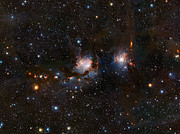In this new image of the nebula Messier 78, young stars cast a bluish pall over their surroundings, while red fledgling stars peer out from their cocoons of cosmic dust. To our eyes, most of these stars would be hidden behind the dust, but ESO’s Visible and Infrared Survey Telescope for Astronomy (VISTA) sees near-infrared light, which passes right through dust. The telescope is like a giant dustbuster that lets astronomers probe deep into the heart of the stellar environment.
Messier 78, or M78, is a well-studied example of a reflection nebula. It is located approximately 1600 light-years away in the constellation of Orion (The Hunter), just to the upper left of the three stars that make up the belt of this familiar landmark in the sky. In this image, Messier 78 is the central, bluish haze in the centre; the other reflection nebula towards the right goes by the name of NGC 2071. The French astronomer Pierre Méchain is credited with discovering Messier 78 in 1780. However, it is today more commonly known as the 78th entry in French astronomer Charles Messier’s catalogue, added to it in December of 1780.
When observed with visible light instruments, like ESO’s Wide Field Imager at the La Silla Observatory, Messier 78 appears as a glowing, azure expanse surrounded by dark ribbons (see eso1105). Cosmic dust reflects and scatters the light streaming from the young, bluish stars in Messier 78’s heart, the reason it is known as a reflection nebula.

For more information about this study, visit:
http://www.eso.org/public/images/eso1635a/
